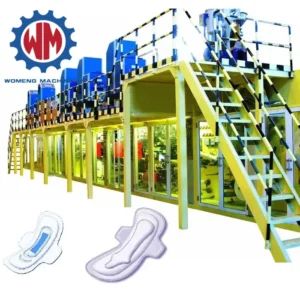Advancements in servo technology have significantly influenced the efficiency of sanitary napkin machines in several ways:
- Precision Control: Modern servo motors offer high precision control over movements, allowing for accurate positioning of machine components. This precision is crucial in achieving consistent product quality and precise material handling.
- Speed and Acceleration: Servo motors enable rapid and precise acceleration and deceleration, contributing to increased production speeds without compromising accuracy. This capability enhances overall machine efficiency.
- Adaptability to Varying Loads: Servo motors can adapt to varying loads and torque requirements during different phases of the production process. This adaptability ensures smooth and consistent operation, regardless of fluctuations in material properties or machine requirements.
- Reduced Maintenance: Advanced servo systems often require minimal maintenance due to their design, resulting in reduced downtime and maintenance costs for the machines.
- Energy Efficiency: Servo motors are known for their energy efficiency. They consume energy only as needed based on the required motion, contributing to overall energy savings in machine operations.
- Synchronization and Coordination: Servo technology allows for precise synchronization and coordination of multiple machine components. This synchronization ensures seamless operation of various sections of the machine, optimizing overall efficiency.
- Enhanced Control Systems: Servo technology often comes integrated with advanced control systems, offering improved connectivity, data analysis, and predictive maintenance capabilities. These systems enhance machine performance and reliability.
- Customization and Flexibility: Servo-driven systems offer greater flexibility and customization options. They allow for easy reprogramming or adjustment of machine settings to accommodate different napkin sizes, shapes, or features, enhancing the machine’s versatility.
- Reduced Noise and Vibration: Advanced servo systems operate with reduced noise and vibration levels compared to traditional systems. This not only improves the working environment but also contributes to the longevity of machine components.
Overall, advancements in servo technology have revolutionized sanitary napkin machines by significantly improving their precision, speed, adaptability, energy efficiency, and overall performance, leading to higher productivity and better quality output.
How is the machine programmed to adjust for varying napkin sizes and shapes?
Machines producing sanitary napkins are designed to be versatile and adaptable to accommodate varying napkin sizes and shapes. Here’s how the programming allows for adjustments:
- Digital Control Systems: These machines are equipped with digital control systems that allow operators to input specific parameters for different napkin sizes and shapes. These parameters include dimensions, cutting patterns, folding configurations, and other relevant settings.
- HMI (Human-Machine Interface): The machine interface provides a user-friendly platform where operators can input the desired napkin specifications. This interface may include touchscreens or software-based systems that allow for easy adjustments.
- Servo Control: Servo motors, known for their precision and programmability, play a crucial role. They control various machine components such as cutters, folders, and positioning mechanisms, adjusting them according to the programmed specifications.
- Motion Profiles: The machine’s programming defines specific motion profiles for different napkin sizes and shapes. These profiles dictate the movement and synchronization of components, ensuring precise cutting, folding, and positioning.
- Positioning Sensors: Sensors integrated into the machine detect the position and alignment of materials. sanitary napkin machine They provide feedback to the control system, ensuring accuracy in material handling and manipulation to achieve the desired size and shape.
- Programmable Logic Controllers (PLCs): PLCs store and execute the programmed instructions for different napkin variations. They manage the sequences of operations required to produce each specific size and shape.
- Automatic Changeover Systems: Some machines feature automatic changeover mechanisms that facilitate quick adjustments between different napkin configurations. These systems minimize downtime by automating the transition between setups.
- Predefined Templates or Recipes: Operators can create and save predefined templates or recipes for various napkin sizes and shapes. These templates store the necessary settings and parameters for quick and easy setup when switching between production runs.
- Testing and Calibration: Before production, the machine undergoes testing and calibration for each napkin size and shape configuration. This ensures that the programmed settings accurately produce the intended results.
By utilizing these programming and control features, sanitary napkin machines can swiftly adapt to varying sizes and shapes, enabling manufacturers to efficiently produce a diverse range of products without compromising on quality or productivity.
